Sixty-three Wreck Tours have passed come and gone since we visited a Castle-class trawler wreck off Dartmouth. JOHN LIDDIARD feels that enough time has passed for him to tackle another one in the same part of the world. His tour is illustrated by MAX ELLIS
BACK IN WRECK TOUR 117, we visited the wreck of the Benton Castle off Dartmouth.
This month we return there and the nearby site of the Picton Castle, a similarly sized and constructed
trawler also sunk by a mine.
As with many such wrecks the difference is in the detail, both in minor points of construction and in
how it has decayed since it sank.
When I dived the Picton Castle the shotline was hooked across the wreck just aft of the bow (1), well
broken and where the mine appears to have exploded.
The two survivors from the crew were standing aft and, I suspect, their report of the mine exploding amid ships was slightly inaccurate.
When a few hundred pounds of explosive detonates beneath such a small ship, a 5m difference in the location of the centre of the explosion won’t be the first thing on your mind as you are blown overboard and cling to floating wreckage.
The wreck sits on a silty seabed at 35m and is well over to port, with the port side of the deck almost in the silt, and the starboard rail at 32m.
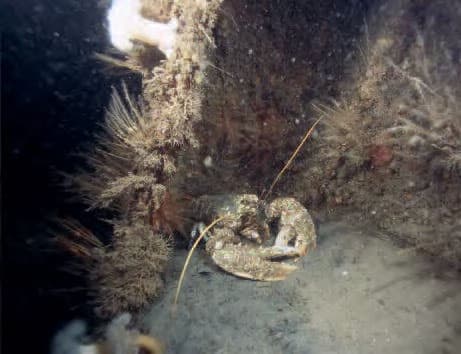
Turning forwards past the collapsed plates of the hull (2), the wreck becomes intact again on reaching the forecastle (3).
The bow is tilted even further to port, with a mast-foot at the back, the usual pairs of bollards to either side and a small anchor-winch (4) close to the stem. Beneath the bow, the seabed is scoured to 37m.
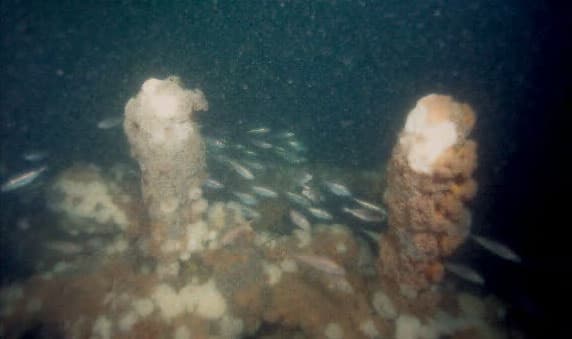
Now turning aft, wreckage from the broken deck (5) spreads out slightly from the hull, and another scour to 37m indicates just how strongly the tide rips through the broken area of the wreck once slack water is over.
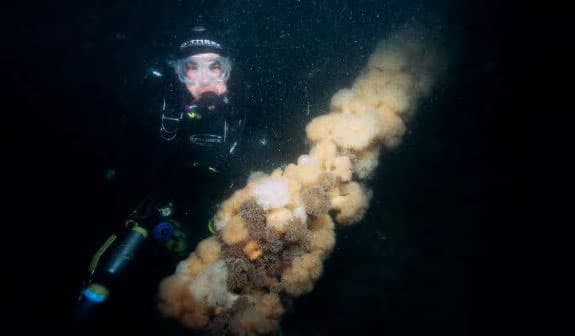
The hull and deck now gains some structure again (6). The helm (7) is located on top of a small deck-house, barely distinguishable beneath a dense covering of plumose anemones. This is surrounded
by an intact railing, suggesting that the helm was originally in the open, or perhaps protected only by a small wooden shelter that is now long decayed.

Ribs sticking out on either side of this platform suggest that the main deck on either side may also have been sheltered by a wooden structure.
Continuing aft, a slightly raised section spanning the middle of the deck runs above the stoke-hold and engine-room.
An oval hole (8) marks where the funnel was attached. It is now filled with debris, but would originally have led to the forward end of the boiler.
The funnel (9) lies on the silt out from the starboard side of the wreck.
The raised section continues above the boiler, past a pair of small hatches and a tubular ventilator to a further raised skylight (10) above the engine.
The Picton Castle was fitted with an 80hp triple-expansion engine, although little is visible through the open hatches.
Behind the engine-room is a larger deckhouse (11) with the arched frames, or trawl-gallows, to either side and a doorway at the back.
Our tour is now at the stern deck of the wreck. Here a square hatch in the centre of the deck is surprisingly still covered (12).
Another mast-foot is located on the centreline, with pairs of bollards to either side.
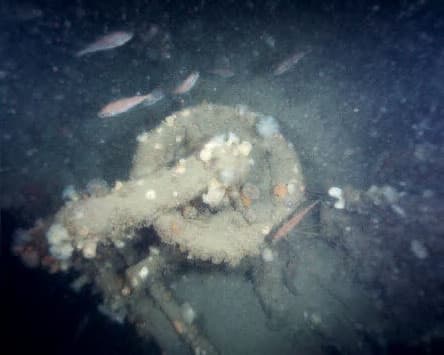
The steering mechanism is a simple T (13). If you look closely, against the gunwales on either side are pulleys that would have routed cables from the T along the sides of the deck and forward to the helm.
Also notable is a changed pattern of deck-beams, from a grid that runs forward to a radial pattern that runs around the stern. Aft of the steering are further pairs of bollards (14).
Continuing “over” the stern, the rudderframe and an iron propeller remain in place (15), rising from the silt as another 2mdeep scour shows where the tide rips round the stern of the wreck.
Having covered the length of the wreck, a clue remains unsolved. One of the survivors, Reginald John Pearce, is listed as a deckhand acting as gunner.
So was there a gun?
I couldn’t find any sign of a gun or gun-mount on the Picton Castle or on the nearby wreck of the Benton Castle, so I suspect that there never was one in the sense of a naval gun mounted to the deck.
After a mine was swept using cables and pulled to the surface, rifle fire would have been used to detonate it.
Would it have been just a rifle that the gunner was responsible for?
With our tour over, it is time to ascend.
Returning a few metres forward along the starboard side of the deck, the starboard trawl-gallow (16) marks the shallowest point of the wreck, and a good place to release a delayed SMB for a drifting
decompression.
SEPARATED IN THE FOG
THE PICTON CASTLE, trawler/minesweeper. BUILT 1911, SUNK 1917
LIKE THE NEARBY WRECK OF THE Benton Castle (Wreck Tour 117), HM Trawler Picton Castle was built by Smith Dock Co Ltd of Middlesbrough. It was just one of many Castle-class trawlers in Admiralty service.
Initially the Castle name was used to represent any trawler in service originally constructed by Smith Dock, so the class covered a wider divergence of design than a typical Navy ship class.
By 1916, the Castle class had become a standard specification for trawlers of 620 tons with a crew of 26 to 32, with some 200 hulls constructed by yards as far afield as the Port Arthur Shipbuilding Co of Ontario.
The Picton Castle predates such hulls, having been built in 1911 for Castle Steam Trawlers Ltd of Swansea with a displacement of only 245 tons, then hired into Admiralty service in May 1915.
The stretch of Lyme Bay leading out from the approaches to Dartmouth had become an area of constant competition between U-boats laying a minefield and Admiralty trawlers sweeping the mines.
At 4.20am on 19 February, 1917, Picton Castle and another trawler, Agnes Wickfield, left Plymouth with instructions to sweep the minefield off Dartmouth. The trawlers initially anchored up in Plymouth Sound to see whether the prevailing thick fog would clear, then proceeded for an agreed rendezvous off Dartmouth, maintaining contact by periodic blasts of their whistles.
Some time after the trawlers rounded Start Point and altered course towards Berry Head, they lost contact. The Agnes Wickfield waited at the rendezvous for a while, then headed into Dartmouth to see if the Picton Castle had done the same.
At 6.45 that evening the fate of the Picton Castle became known, when two of the crew were picked up from the water by a patrol vessel.
She had struck a mine laid by UC70 some three miles off Dartmouth.
Reginald John Pearse of Newquay, a deck-hand acting as gunner, reported that he had been standing aft when a mine exploded amidships and the Picton Castle went straight to the bottom. The remaining 12 crew did not survive.
UC70 subsequently became notable as the result of being sunk by an aircraft-dropped bomb off Whitby on 28 August, 1918 (Wreck Tour 10).
TOUR GUIDE
GETTING THERE: From the M5 and then the A38, turn left onto the A380 and A3022 for Torquay.
HOW TO FIND IT: The GPS co-ordinates are 50 18.368 N, 003 32.255 W (degrees, minutes and decimals). The Picton Castle lies in a scour up to 5m deep on a silty seabed. The bow points to the south-east.
TIDES: Slack is three hours after or two hours before high water Dartmouth, with the best visibility being after high water.
DIVING: Jennifer Ann Website, 01803 607704
AIR: Nautique, 01803 550278. Riviera Diving & Watersports, 01803 607135.
ACCOMMODATION: Tor Dean Hotel, Torquay, 01803 294669.
LAUNCHING: Slips at Paignton, Brixham and Dartmouth.
QUALIFICATIONS: An advanced air dive suitable for BSAC Dive Leader or other agencies with Advanced Nitrox & Deco Procedures.
FURTHER INFORMATION: Admiralty Chart 3315, Berry Head to Bill of Portland. Ordnance Survey Map 202, Torbay & South Dartmoor Area. World War One Channel Wrecks, by Neil Maw. Dive South Devon, by Kendall McDonald. Shipwreck Index of the British Isles Vol 1, by Richard & Bridget Larn.
PROS: Compact enough that it can be seen all in one dive without getting too far into decompression.
CONS: Visibility can be low, especially after heavy rainfall.
DEPTH: 20-35m
Thanks to Steve Mackay and Andy Micklewright.
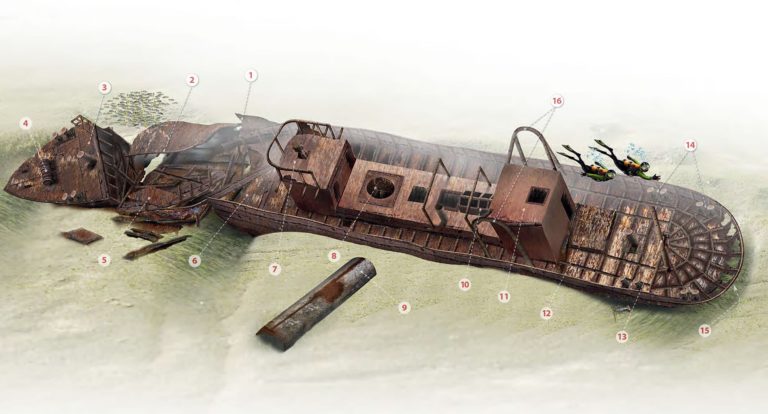

My grandfather was one of the crew killed
There’s a ship with the same name and history as this one, except she didn’t sink but was found in (Norway?) by Captain D. Moreland as a rusting hull worthy of a new life and converted to a circumnavigating barque. She’s still floating and going to sea (I sailed on her!), so I’m a tad confused…